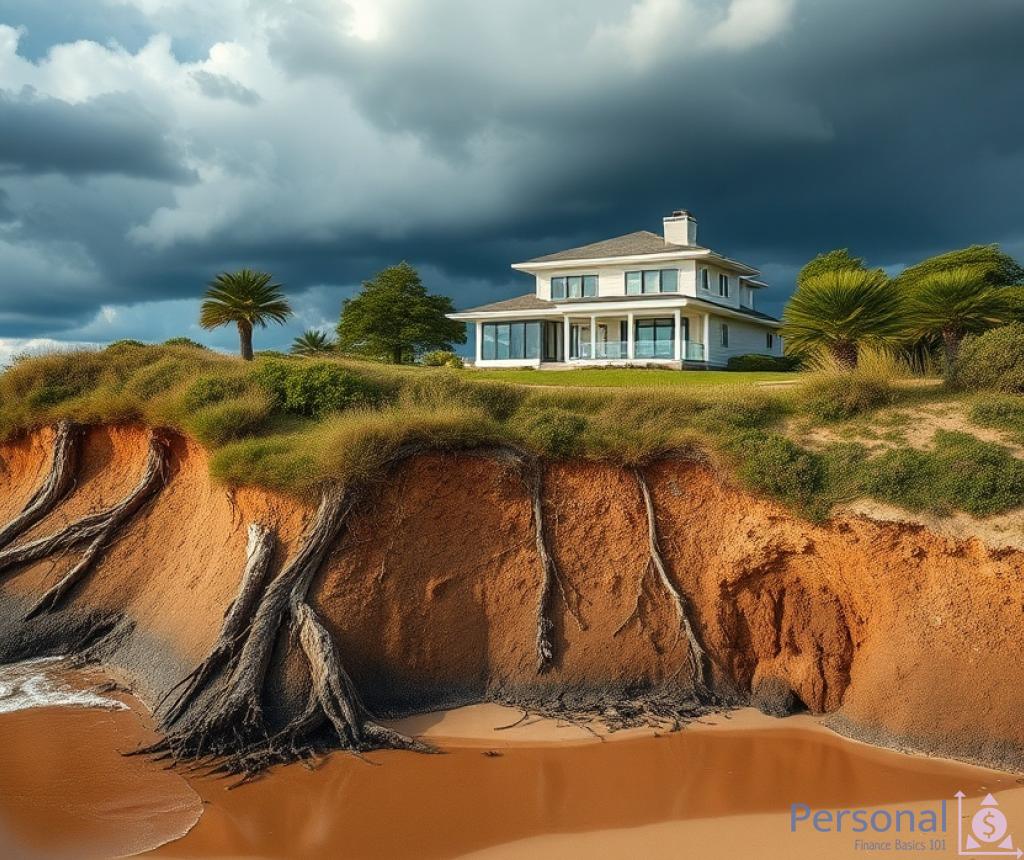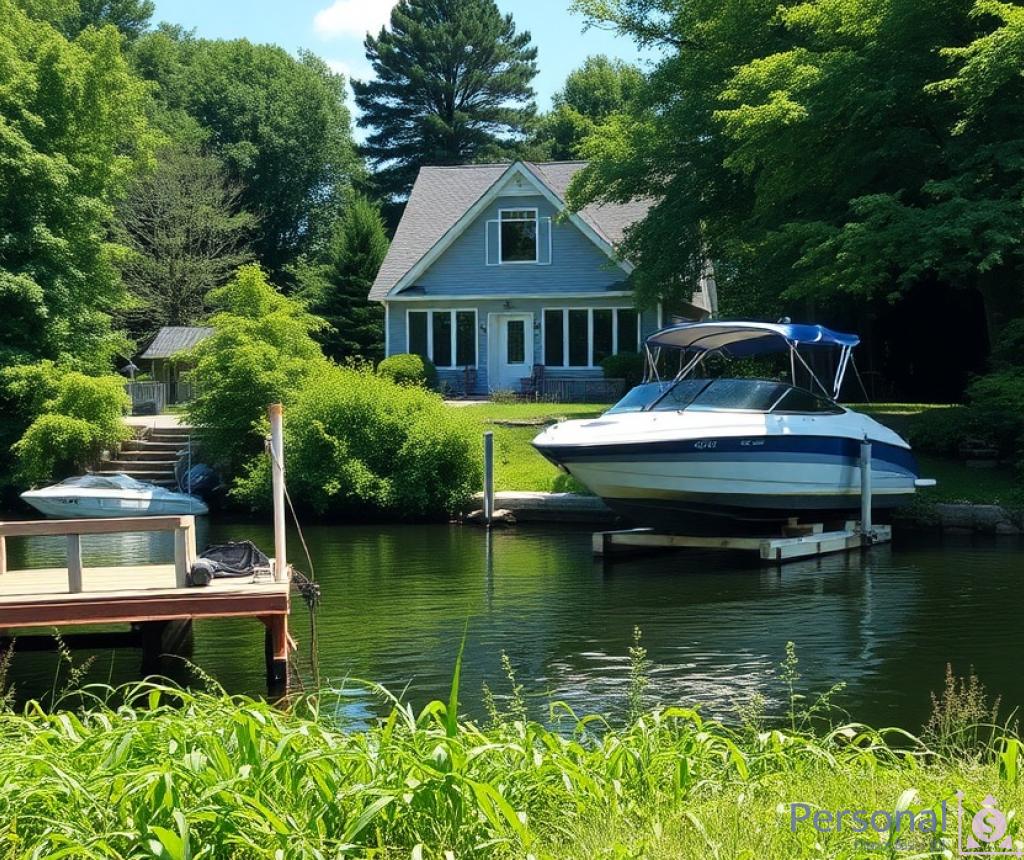Understanding Coastal Erosion Risks

Recognizing the Threat of Coastal Erosion
Coastal erosion is a significant concern for property owners along shorelines and lakesides. It refers to the gradual loss of land due to the relentless action of waves, currents, and tides. For homeowners and potential buyers of waterfront properties, understanding the implications of coastal erosion is essential, as it can affect property value, safety, and insurance costs.
Evaluating Erosion Zones: A Critical Step for Homebuyers
Before investing in a waterfront property, it is crucial to evaluate the erosion potential of the area. Coastal zones are often classified based on their vulnerability to erosion, which can be influenced by factors such as the geological composition of the shoreline, local weather patterns, and human activities. Homebuyers should not only look at current conditions but also consider historical erosion data to assess the long-term risks.
| Erosion Risk Classification | Description |
|---|---|
| Low Risk | Areas where erosion is minimal and infrequent, often stabilized by natural vegetation. |
| Moderate Risk | Regions that experience some erosion but have protective measures in place, such as seawalls or breakwaters. |
| High Risk | Vulnerable areas where erosion is significant and ongoing, requiring regular monitoring and potential mitigation efforts. |
Proactive Measures: Protecting Your Investment
Once you have identified the risk level associated with your waterfront property, taking proactive measures can significantly mitigate potential damage from coastal erosion. Homeowners can invest in various protective strategies, including landscaping with native plants that stabilize the soil, constructing barriers to absorb wave energy, or implementing advanced engineering solutions. Additionally, regular monitoring and maintenance of these protective measures can ensure their effectiveness over time.
By understanding coastal erosion risks and implementing protective measures, waterfront property owners can safeguard their investments and enjoy their homes with greater peace of mind.
Regulatory Considerations for Waterfront Development
When contemplating the development of waterfront properties, understanding the regulatory landscape is paramount. Local, state, and federal laws can significantly influence the feasibility of your project. These regulations are designed not only to protect the environment but also to preserve the integrity of these unique ecosystems. Navigating this complex framework can be daunting, yet it is essential for ensuring that your development aligns with legal requirements and environmental stewardship.
Understanding Permits and Zoning Regulations
The journey toward developing a waterfront property begins with a thorough understanding of the necessary permits and zoning regulations. Each region has its own set of rules governing land use, construction, and environmental impact. It is crucial for developers and homeowners to engage with local planning authorities early in the process to ascertain what specific permits are required.
- Building Permits: Required for construction, renovation, or expansion of structures.
- Environmental Permits: Necessary for any project that may impact wetlands, floodplains, or coastal resources.
- Zoning Approvals: Ensure that the intended use of the property complies with local zoning laws.
- Coastal Zone Management Permits: May be required in coastal areas to ensure sustainable development practices.
Understanding the specific requirements for your location will help prevent delays and potential legal issues down the road.
Environmental Impact Assessments: A Necessary Step
Before proceeding with development, it is often required to conduct an Environmental Impact Assessment (EIA). This assessment evaluates the potential effects of the proposed project on the local environment, including wildlife habitats, water quality, and shoreline stability. Engaging with environmental consultants can provide insights into how to minimize negative impacts and adhere to ecological guidelines.
Moreover, an EIA can also enhance the credibility of your project in the eyes of local authorities and the community, potentially easing the approval process. By demonstrating a commitment to environmental responsibility, developers can not only comply with regulations but also foster goodwill within the community.
Engaging with Stakeholders for Sustainable Development
Building relationships with stakeholders, including local communities, environmental groups, and governmental bodies, is essential for successful waterfront development. Open communication can lead to collaborative solutions that benefit both developers and the environment. Hosting community forums and soliciting feedback can help identify concerns and expectations, ultimately shaping a project that is more likely to receive support and approval.
In summary, understanding regulatory considerations for waterfront development is crucial for ensuring project success. By navigating permits, conducting environmental assessments, and engaging with stakeholders, developers can create sustainable waterfront properties that are not only compliant with regulations but also enhance the natural beauty and health of their surroundings.
Maintenance Challenges Unique to Lakeside Living

Lakeside properties offer picturesque views and a serene lifestyle, but they also come with their own set of maintenance challenges that homeowners must navigate. Understanding these specific issues is crucial for preserving the beauty and functionality of your lakeside home. From water-related wear and tear to seasonal upkeep, the unique environment demands a proactive approach to maintenance.
Water Quality Management: A Constant Vigilance
The proximity to water bodies means that homeowners need to be vigilant about water quality. Lakes can be prone to algae blooms, sedimentation, and pollution, which can affect both the aesthetics and safety of the water. Regular testing of water quality not only ensures safe swimming conditions but also protects the integrity of any personal watercraft or dock systems. Homeowners may need to invest in filtration systems or treatments that can mitigate these issues, ensuring that their lakeside experience remains enjoyable.
Structural Integrity: Battling Moisture and Weather Elements
The constant exposure to moisture and fluctuating weather conditions can lead to significant challenges regarding the structural integrity of lakeside homes. Foundation issues, mold growth, and wood rot are common problems that can arise due to high humidity and water proximity. It is essential to conduct regular inspections of the home’s foundation, roofing, and siding to catch any signs of wear early. Implementing proper drainage systems and utilizing moisture-resistant building materials can also help in prolonging the lifespan of the property.
Seasonal Upkeep: Preparing for Nature’s Extremes
Lakeside living also requires a keen awareness of seasonal changes, which can bring unique maintenance tasks. Whether it’s winterizing a dock or preparing landscaping for heavy rainfall, homeowners must stay ahead of the seasonal curve. Below is a list of essential seasonal maintenance tasks for lakeside properties:
- Spring: Inspect and repair docks, clean gutters and downspouts, and check for any winter damage.
- Summer: Regularly maintain landscaping, monitor water quality, and ensure that outdoor furniture is weather-resistant.
- Fall: Prepare for winter by securing outdoor items, cleaning leaves from the property, and inspecting heating systems.
- Winter: Ensure that pipes are insulated, remove snow from roofs and decks, and winterize boats and watercraft.
By staying informed about these maintenance challenges and proactive in their approach, homeowners can enjoy the many rewards of lakeside living while minimizing potential pitfalls.
Insurance Implications for Waterfront Properties
Understanding Insurance Coverage for Unique Risks
Waterfront properties, whether situated along the coast or nestled by serene lakes, present unique insurance challenges that are distinct from traditional homes. Due to their proximity to water, these properties are often exposed to heightened risks such as flooding, erosion, and severe weather events. Consequently, homeowners must navigate a complex insurance landscape to ensure adequate protection for their valuable assets.
Prior to purchasing a waterfront property, potential buyers should thoroughly explore various insurance options tailored to these specific risks. Homeowners insurance alone may not suffice; additional coverage may be necessary to comprehensively protect against water-related damages.
Essential Insurance Types for Waterfront Homeowners
When considering insurance for waterfront properties, it’s vital to recognize the different types of coverage that may be required. Each type can play a crucial role in safeguarding a homeowner’s investment from potential disaster.
- Flood Insurance: Given the susceptibility of waterfront properties to flooding, acquiring a separate flood insurance policy is often essential. Standard home insurance policies typically exclude flood damage, making this coverage indispensable for safeguarding against sudden water incursions.
- Windstorm Insurance: Coastal properties are particularly vulnerable to high winds and hurricanes. Windstorm insurance can help cover repairs or replacements needed due to wind-related damages.
- Erosion Insurance: For properties at high risk of erosion, additional coverage may be necessary to protect against land loss. This type of insurance can help mitigate the financial impact of gradual land erosion.
- Liability Insurance: With waterfront properties often featuring docks or piers, liability insurance is crucial. It protects homeowners from potential lawsuits arising from accidents that may occur on their property.
Evaluating Insurance Costs and Coverage Levels
Understanding the costs associated with insuring a waterfront property is just as important as the coverage types. Insurance premiums for waterfront homes can vary widely based on several factors, including location, property value, and the risk of natural disasters. Homeowners should conduct a thorough evaluation of their insurance options to ensure they are receiving adequate coverage without overextending their budgets.
To facilitate this comparison, homeowners can use the following table, which outlines common factors influencing insurance costs for waterfront properties:
| Factor | Description | Impact on Premium |
|---|---|---|
| Location | Proximity to water bodies and flood zones | Higher risk areas typically lead to increased premiums |
| Property Value | Market value of the home and land | More expensive properties incur higher insurance costs |
| Construction Type | Building materials and architecture | Wooden structures may have higher fire and flood risks |
| Historical Data | Past claims and weather patterns in the area | Regions with frequent claims may face steeper premiums |
By understanding the insurance implications associated with waterfront properties, homeowners can make informed decisions that will protect their investments and provide peace of mind amidst the uncertainties of coastal and lakeside living.
Environmental Impact Assessments for Coastal Homes
Assessing the Ecological Footprint of Coastal Developments
As the allure of coastal living grows, so does the necessity for rigorous Environmental Impact Assessments (EIAs). These assessments are crucial for understanding how proposed developments may affect the delicate ecosystems of coastal regions. Coastal homes, positioned at the intersection of land and sea, require a thorough examination to ensure that environmental integrity is maintained while accommodating human interests.
Conducting an EIA involves evaluating multiple factors, including habitat destruction, water quality, and the potential for increased erosion. Developers must consider not only immediate impacts but also the long-term implications of their projects on the coastline’s health. The findings of an EIA can guide developers in making informed decisions that minimize ecological disruption while enhancing community resilience against environmental changes.
The Importance of Stakeholder Involvement
Engaging local communities and environmental advocates in the EIA process is paramount. Their insights can unveil community-specific concerns that may not be immediately apparent to developers. This collaborative approach fosters transparency and cultivates goodwill among stakeholders, ultimately leading to more sustainable coastal development outcomes.
Additionally, effective stakeholder engagement can facilitate the identification of mitigation strategies. For example, if an EIA reveals significant risks to local wildlife habitats, developers can work with environmental groups to implement protective measures, such as creating buffer zones or restoring native vegetation. By prioritizing stakeholder involvement, developers can not only improve project designs but also enhance their reputation within the community.
Evaluating Ecosystem Services and Resilience
Another critical dimension of EIAs for coastal homes is the assessment of ecosystem services that coastal environments provide. These services include flood protection, water purification, and habitat for diverse species. Understanding the value of these services is essential for justifying the preservation of natural landscapes that often mitigate the impacts of climate change.
To illustrate the relationship between coastal development and ecosystem resilience, consider the following table:
| Impact Category | Potential Consequences | Mitigation Strategies |
|---|---|---|
| Wetland Loss | Increased flooding and loss of biodiversity | Restore and create new wetlands |
| Erosion | Property damage and habitat degradation | Implement natural barriers and vegetation |
| Water Quality | Pollution and harmful algal blooms | Install filtration systems and reduce runoff |
By emphasizing the significance of ecosystem services in EIAs, developers can advocate for approaches that not only protect coastal properties but also foster environmental stewardship. This will ensure that coastal communities thrive in harmony with their natural surroundings, preserving the beauty and functionality of waterfront living.
Disclaimer
This article has been created or edited with the support of artificial intelligence and is for informational purposes only. The information provided should not be considered investment advice. Please seek the support of a professional advisor before making any investment decisions.






